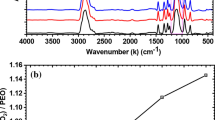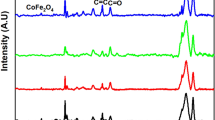Abstract
Polyethylene oxide (PEO) complexed with molecular iodine (I2) forming PEO/I2 complex composites stand‐free films were investigated using dielectric relaxation, X-ray photoelectron spectroscopy (XPS), UV–Vis spectrophotometry, structural and morphological techniques. Scanning electron microscopy was used to monitor the variation in the surface morphology and the related roughness. 2D Energy-dispersive X-ray spectroscopy (EDX) measurements enabled to observe the distribution of iodine on the film surface. High resolution XPS measurements were used to define the iodine anion types and the metallic iodine existence, as well as the relevant concentrations based on the binding energies. The dielectric relaxation measurements were carried out over the frequency range from 0.1 to 107 Hz and temperature range from 155 to 330 K. Dielectric loss (ε′′) curves were fitted to the Havriliak–Negami (HN) model for one and/or two relaxation peaks (α and β), with and without the electrical conductivity contribution term, in order to deduce the relaxation time (τ) and the dielectric strengths (Δε), in addition to the electrical conductivities (σ). The temperature-dependent data of β- and σ- relaxations follow the law of Arrhenius thermal activation indicating the presence of typical glass-forming polymers. Δε of α-relaxation obeys the curvature pattern of Vogel-Tammann-Fulcher (VTF) thermal activation law. The electrical conductivity of the system increases 6000 folds by doping PEO with 5 wt% of iodine at the same temperature (293 K).









Similar content being viewed by others
References
Jin X, Zhang S, Runt JJP (2002) Observation of a fast dielectric relaxation in semi-crystalline poly (ethylene oxide). Polymer 43:6247–6254
Amjadi M, Pichitpajongkit A, Lee S, Ryu S, Park I (2014) Highly stretchable and sensitive strain sensor based on silver nanowire–elastomer nanocomposite. ACS Nano 8:5154–5163
Lin D, Yuen PY, Liu Y, Liu W, Liu N, Dauskardt RH, Cui Y (2018) A silica-aerogel-reinforced composite polymer electrolyte with high ionic conductivity and high modulus. Adv Mater 30(32):1802661
Aldalur I, Martinez-Ibañez M, Piszcz M, Rodriguez-Martinez LM, Zhang H, Armand M (2018) Lowering the operational temperature of all-solid-state lithium polymer cell with highly conductive and interfacially robust solid polymer electrolytes. J Power Sour 383:144–149
Money BK, Hariharan K, Swenson J (2012) A dielectric relaxation study of nanocomposite polymer electrolytes. Solid State Ion 225:346–349
Money BK, Swenson J (2013) Dynamics of poly (ethylene oxide) around its melting temperature. Macromolecules 46:6949–6954
Chand S, Mehendru P (1986) Electrical conduction in PVF2 films: the effect of iodine. J Phys D Appl Phys 19:857
Dai L, Maua AWH, Griesser HJ, Spurling TH, Hong X, Yang Y, White JW (1995) “I2-Doping” of 1, 4-polydienes. Synth Met 69:563–566
Le T-H, Kim Y, Yoon HJP (2017) Electrical and electrochemical properties of conducting polymers. Polymers 9:150
Singh R, Shrivastava AK, Bajpai AK (2019) CdSe reinforced polyaniline nanocomposites as superior material for future applications as gas sensor and diodes. Mater Res Express 6:1250a9
Palácio G et al (2018) Coupling photoluminescence and ionic conduction Properties using the different coordination sites of ureasil-polyether hybrid materials. ACS Appl Mater Interfaces 10:37364–37373
Smith MB, March J (2007) March’s advanced organic chemistry: reactions, mechanisms, and structure. Wiley, NewJersey
Lyday PA (2005) Iodine and iodine compounds. Ullmann’s Encyclopedia of Industrial Chemistry, Wiley, Weinheim
Emsley J (2011) Nature’s building blocks: an AZ guide to the elements. Oxford University Press, England
Ibrahim S, Rehim MA, Turky G (2019) Dielectric study of polystyrene/polycaprolactone composites prepared by miniemulsion polymerization. J Phys Chem Solids 119:56–66
Seto M, Maeda Y, Matsuyama T, Yamaoka H, Sakai H (1993) Mössbauer spectroscopic study of fullerene C60 doped with iodine. Nucl Instrum Methods Phys Res Sect B Beam Interact Mater Atoms 76:348–349
Darwish AG, Ghoneim AM, Hassaan MY, Shehata OS, Turky GM (2019) Impact of RGO on electrical and dielectric properties of Co3O4/RGO nanocomposite. Mater Res Express 6:105039
Moussa MA, Ghoneim AM, Abdel Rehim MH, Khairy SA, Soliman MA, Turky GM (2017) Relaxation dynamic and electrical mobility for poly(methyl methacrylate)-polyaniline composites. J Appl Polym Sci 134:45415–45425
Telfah A, Jafar MMAG, Jumh I, Ahmad MJA, Lambert J, Hergenröder R (2018) Identification of relaxation processes in pure polyethylene oxide (PEO) films by the dielectric permittivity and electric modulus formalisms. Polym Adv Technol 29:1974–1987
Gray FM (1991) Solid polymer electrolytes: fundamentals and technological applications. VCH, New York
Havriliak S, Negami S (1967) A complex plane representation of dielectric and mechanical relaxation processes in some polymers. Polymer 8:161–210
Cai W, Österberg T, Jafari MJ, Musumeci C, Wang C, Zuo G, Yin X, Luo X, Johansson J, Kemerink M, Ouyang L, Ederth T, Inganäs O (2020) Dedoping-induced interfacial instability of poly(ethylene imine)s-treated PEDOT:PSS as a low-work-function electrode. J Mater Chem C 8:328–336
Mizuno M, Tanaka J, Harada I (1981) Electronic spectra and structures of polyiodide chain complexes. J Phys Chem 85:1789–1794
Gutierrez J, Tercjak A, Garcia I, Peponi L, Mondragon I (2008) Hybrid titanium dioxide/Ps-b-PEO block copolymer nanocomposites based on sol–gel synth- esis. Nanotechnology 19:155607
Voigt EM (1968) Absorption maxima of the visible band of iodine in different groups of solvents. J Phys Chem 72:3300–3305
Naorem H, Devi SD (2013) Spectrophotometric determination of the formation constant of triiodide ions in aqueous-organic solvent or polymer mixed media both in absence and presence of a surfactant. Spectrochim Acta Part A Mol Biomol Spectrosc 101:67–73
Guttman DE, Higuchi T (1955) Study of possible complex formation between macromolecules and certain pharmaceuticals. IX. Formation of iodine-iodide complexes with polyethylene glycol. J Am Pharm Assoc Am Pharm Assoc 44:668–678
Pullen S, Walker LA, Sension RJ (1995) Femtosecond studies of the iodine–mesitylene charge-transfer complex. J Chem Phys 103:7877–7886
Pron A, Rannou P (2002) Processible conjugated polymers: from organic semiconductors to organic metals and superconductors. Prog Polym Sci 27:135–190
Bredas J-L (1985) Relationship between band gap and bond length alternation in organic conjugated polymers. J Chem Phys 82:3808–3811
Bredas JL, Street GB (1985) Polarons, bipolarons, and solitons in conducting polymers. Acc Chem Res 18:309–315
Brédas J-L, Scott JC, Yakushi K, Street GB (1984) Polarons and bipolarons in polypyrrole: evolution of the band structure and optical spectrum upon doing. Phys Rev B 30:1023
Jarząbek B, Hajduk B, Jurusik J, Domański M (2017) In situ optical studies of thermal stability of iodine-doped polyazomethine thin films. Polym Test 59:230–236
Rajendra Kumar G, Dennyson Savariraj A, Karthick SN, Selvam S, Balamuralitharan B, Kim H-J, Viswanathan KK, Vijaykumar M, Prabakar K (2016) Phase transition kinetics and surface binding states of methylammonium lead iodide perovskite. Phys Chem Chem Phys 18:7284–7292
Ng T-W, Chan C-Y, Lo M-F, Guan ZQ, Lee C-S (2015) Formation chemistry of perovskites with mixed iodide/ chloride content and the implications on charge transport properties. J Mater Chem A 3:9081–9085
Zhang J, Song T, Zhang Z, Ding K, Huang F, Sun B (2015) Layered ultrathin PbI 2 single crystals for high sensitivity flexible photodetectors. J Mater Chem C 3:4402–4406
Salaneck WR, Thomas HR, Bigelow RW, Duke CB, Plummer EW, Heeger AJ, MacDiarmid AG (1980) Photoelectron spectroscopy of iodine-doped polyacetylene. J Chem Phys 72:3674–3678
Sherwood PMA (1976) NIST X-ray photoelectron spectroscopy database. J Chem Soc Faraday Trans II 72:1806
Bhat SN, Dwivedi R (1980) Transference number of charge-transfer complexes in solutions: methanol-iodine and ethanol-iodine, Proc. Indian Acad. Sci. (Chem. Sci.) 89:337–340
Tristant D, Puech P, Gerber IC (2015) Theoretical study of polyiodide formation and stability on monolayer and bilayer graphene. Phys Chem Chem Phys 17:30045–30051
Hemalatha S, Chandani B, Balasubramanian D (1979) Complexation of molecular iodine by linear poly (ethylene glycol). Spectrosc Lett 12:535–541
Dave G, Kanchan DK (2018) A. Physics, Dielectric relaxation and modulus studies of PEO-PAM blend based sodium salt electrolyte system. Indian J. Pure Appl. Phys 56:978–988
Arya A, Sharma AL (2018) Effect of salt concentration on dielectric properties of Li-ion conducting blend polymer electrolytes. J Mater Sci Mater 29:17903–17920
Sharma AL, Thakur AK (2011) AC conductivity and relaxation behavior in ion-conducting polymer nanocomposite. Ionics 17:135–143
Arya A, Sharma AL (2019) Dielectric relaxations and transport properties parameter analysis of novel blended solid polymer electrolyte for sodium-ion rechargeable batteries. J Mater Sci 54:7131–7155
Yang K, Huang X, Huang Y, Xie L, Jiang P (2013) Fluoro-Polymer@BaTiO3 hybrid nanoparticles prepared via RAFT polymerization: toward ferroelectric polymer nanocomposites with high dielectric constant and low dielectric loss for energy storage application. Chem Mater 25:2327–2338
Martínez-Tong DE, Miccio LA, Alegria A (2017) Ionic transport in the amorphous phase of semicrystalline polyethylene oxide thin films. Soft Matter 13:5597
Jiang B, Peng H, Wu W, Jia Y, Zhang Y (2016) Numerical simulation and experimental investigation of the viscoelastic heating mechanism in ultrasonic plasticizing of amorphous polymers for micro injection molding. Polymers 8:199
Balani K, Verma V, Agarwal A, Narayan R (2014) Physical, thermal, and mechanical properties of polymers. Wiley, United States
Sapri MNZM, Ahmad AH (2015) Conductivity and dielectric studies of pure and doped poly (Ethylene oxide)(PEO) solid polymer electrolyte films. Jurnal Teknologi 76:47–51
Schönherr H, Frank CWJM (2003) Ultrathin films of poly (ethylene oxides) on oxidized silicon. 1. Spectroscopic characterization of film structure and crystallization kinetics. Macromolecules 36:1188–1198
Ji J, Li B, Zhong W-H (2010) Effects of a block copolymer as multifunctional fillers on ionic conductivity, mechanical properties, and dimensional stability of solid polymer electrolytes. J. Phys. Chem. B 114:13637–13643
Money BK, Hariharan K, Swenson JJSSI (2014) Relation between structural and conductivity relaxation in PEO and PEO based electrolytes. Solid State Ion 262:785–789
Sengwar RJ, Kaur K (2003) Dielectric properties and a.c. electrical conductivity of aqueous solution grown pure and iodine doped poly (vinyl alcohol) films. Indian J Eng Mater Sci (IJEMS) 10:492–497
Levit R, Martinez-Garcia JC, Ochoa DA et al (2019) The generalized Vogel-Fulcher-Tamman equation for describing the dynamics of relaxor ferroelectrics. Sci Rep 9:12390
Seto M, Maeda Y, Matsuyama T, Yamaoka H, Sakai H (1993) Mössbauer spectroscopic study of fullerene C60 doped with iodine. Nucl Instrum Methods Phys Res, Sect B 76:348–349
Karlsen EM, Spanget-Larsen J (2009) FTIR investigation of the reaction between pyridine and iodine in a polyethylene host. Form of N-Iodopyridinium Polyiodide, Chem Phys Lett 473:227–232
Pradhan DK, Choudhary R, Samantaray BJEPL (2008) Studies of structural, thermal and electrical behavior of polymer nanocomposite electrolytes. Express Polym Lett 2:630–638
Zhou Y, Wanga Q (2020) Advanced polymer dielectrics for high temperature capacitive energy storage. J Appl Phys 127:240902
Acknowledgements
The authors would like to thank Jordan University of Science and Technology; this research was supported by the Deanship of Scientific Research under Grant Number: 420/2019. The authors extend thanks to the Lehrstuhl Experimentelle Physik III, Technische Universität Dortmund, Germany for offering the measurements via the broadband impedance spectroscopy and the full technical and experimental support.
Author information
Authors and Affiliations
Corresponding author
Additional information
Publisher's Note
Springer Nature remains neutral with regard to jurisdictional claims in published maps and institutional affiliations.
Rights and permissions
About this article
Cite this article
Telfah, A., Al-Akhras, MA., Al-Izzy, K.A. et al. Dielectric relaxation, XPS and structural studies of polyethylene oxide/iodine complex composite films. Polym. Bull. 79, 3759–3778 (2022). https://doi.org/10.1007/s00289-021-03593-1
Received:
Revised:
Accepted:
Published:
Issue Date:
DOI: https://doi.org/10.1007/s00289-021-03593-1




